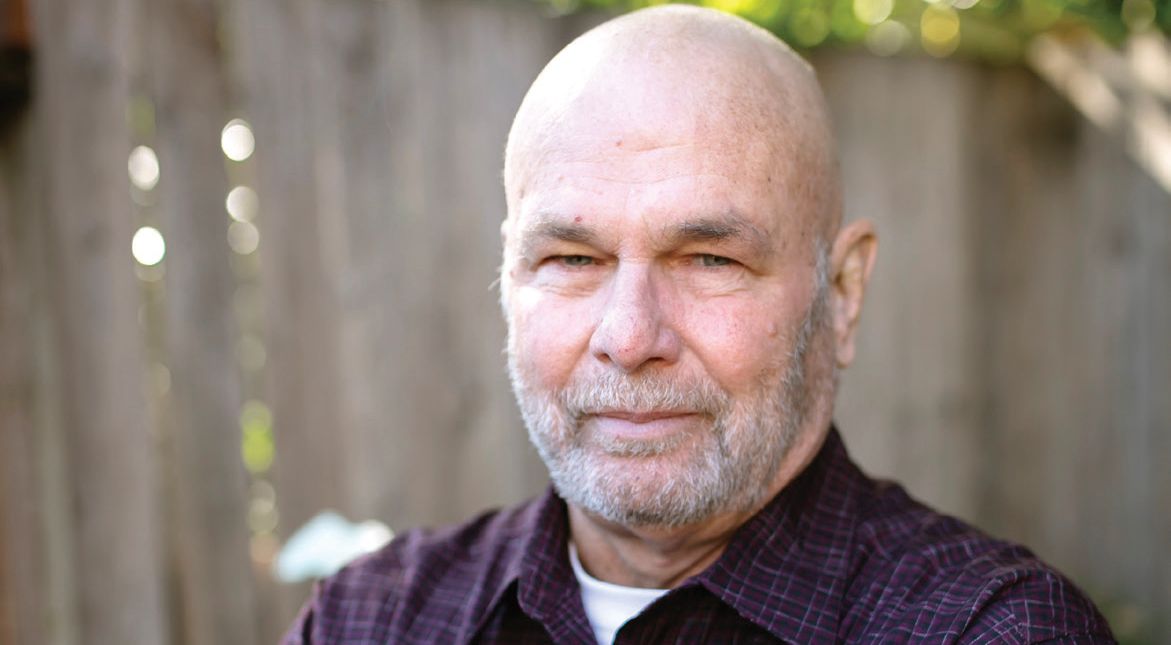Under New Management
A new expert guideline for managing immunotherapy’s side effects has been released.
MELISSA CROUSE says she believes it was immunotherapy that caused neuropathy in her legs. - Photo by NATASHA CUEVAS

MELISSA CROUSE says she believes it was immunotherapy that caused neuropathy in her legs. - Photo by NATASHA CUEVAS
Melissa Crouse has taken more than a dozen medications to treat the lung cancer that was first diagnosed in 2005. She has used traditional standbys, such as carboplatin and Taxol (paclitaxel), and tried cutting-edge drugs during clinical studies. Each treatment produced significant side effects.
The immunotherapy Opdivo (nivolumab), which she began taking in early 2016, seemed different. The first injection came and went … no side effects. The second injection and another two followed … nothing. Crouse felt better than she’d ever felt on cancer medication. The drug seemed entirely benign.
Then her legs began to weaken and ache. Crouse assumed it was an Opdivo side effect but never knew for sure. Her cancer progressed. She switched medications. “My calves still ache to this day. A nerve study found neuropathy, but my doctor says there’s nothing that can be done to fix it,” says Crouse, a 63-year-old resident of Cape Coral, Florida, who used to teach middle school orchestra and chorus. “It’s hard to imagine getting leg damage from a lung cancer treatment, but there’s no other suspected cause. … It was a completely unexpected problem.”
Crouse isn’t alone. Despite their well-justified reputation for being better tolerated than many cancer treatments, immunotherapies known as checkpoint inhibitors lead to serious side effects in a significant minority of patients. These medications deactivate immune system safeguards that keep the body from attacking tumors, but also from damaging normal cells.
Patients should report any side effects immediately because they can worsen with time, but that’s not always easily accomplished. Symptoms can be hard to identify because checkpoint inhibitors can trigger a wide range, including many not traditionally associated with cancer care — and at any time. In fact, the medications are most likely to cause problems after months of trouble-free treatment have led patients to believe that they aren’t going to experience any side effects.
And besides the understanding that people with a history of autoimmune disease have an elevated risk of immunotherapy side effects and need to be monitored closely, doctors don’t yet know how to predict which patients will experience symptoms.
Doctors and nurses have been teaching patients what to look for since 2011, when checkpoint inhibitors first hit the market, but now two learned societies have jointly published more systematic and comprehensive guidelines for identifying and treating side effects that stem from use of checkpoint inhibitors. The advice applies to patients across the spectrum of cancers these medications are approved to treat — so far, nonsmall cell lung, bladder, stomach, liver, cervical and kidney cancers, as well as melanoma, head and neck squamous cancers, Merkel cell carcinoma, classic Hodgkin lymphoma and any cancer classified as mismatch repair deficient.
The guidelines do not discuss side effects related to other cell-based immunotherapy types, such as chimeric antigen receptor (CAR)-T cell therapy or the prostate cancer vaccine Provenge (sipuleucel-T), but the American Society of Clinical Oncology expects to add information related to CAR-T treatments later this year.
To create the documents, the society and the National Comprehensive Cancer Network convened expert panels to synthesize all existing research into a set of best practices. However, because research has yet to definitively answer a number of relevant questions, the guidelines reflect expert opinion and may change as the results of new studies emerge.
The primary goal of both organizations is to educate doctors, but their publications can help patients spot side effects early and get properly treated. “The guidelines contain a huge amount of information, but the most important points for patients to take away are reasonably simple,” says Igor Puzanov, M.D., director of the early phase clinical trials program and melanoma chief at Roswell Park Comprehensive Cancer Center in Buffalo, New York. “Listen to your body. Report anything unusual to a doctor. Make sure the doctor knows you’re taking immunotherapy.”
Immunotherapies create side effects by revving up the immune system so that it attacks healthy cells along with tumors. The most common manifestations are flu-like symptoms and a variety of skin conditions, but the possibilities are numerous. The guidelines also discuss adrenal insufficiency (lack of the hormone cortisol, which is important for regulating blood pressure, heart function and metabolism), hypothyroidism, vision impairment, lung inflammation, kidney failure, Guillain- Barré syndrome (which causes the immune system to attack the nerves), peripheral neuropathy, brain swelling, heartbeat irregularities, hyperglycemia and more than a dozen other possible side effects. Hence the advice that patients listen closely to their bodies: Nearly any problem, no matter when it occurs, could be a side effect of immunotherapy. Issues can arise weeks or even months after patients stop taking the medications.
The second imperative — report anything unusual — addresses two mistakes: the assumption that minor problems will just go away and the fear that calling attention to side effects could mean losing out on an effective treatment.
The first assumption often holds true for side effects related to traditional therapies such as chemotherapy or radiation, which may be most bothersome immediately after treatment and then steadily dissipate. Immune responses, however, sometimes build rather than ebb, the authors of the new guidelines say, so today’s minor side effect can be serious tomorrow. Early intervention minimizes damage and maximizes the chance that treatment can continue.
The belief that stopping treatment will halt therapeutic benefit also holds true for traditional drugs but not for immunotherapy. Traditional treatments attack cancer directly — no treatment means no attacks.
However, even when an unwanted immune response forces patients to stop using checkpoint inhibitors, their immune systems often continue to assault tumors. Patients in clinical trials who have discontinued immunotherapy because of side effects typically live about as long as patients who complete treatment.
In one study of 19 patients with kidney cancer, all stopped taking a checkpoint inhibitor early due to side effects, with a median time on treatment of 5.5 months.
After stopping immunotherapy, four patients experienced an immediate worsening of their cancer, while eight had a durable response and remained off all therapy for at least six months. Furthermore, a 2017 analysis of clinical trials showed that 40 percent of 409 patients with advanced melanoma halted combination immunotherapy due to side effects and fared as well as those who continued on the drugs. The patients stopped immunotherapy before completing a four-dose induction regimen.
“It’s very natural for patients who are responding to a cancer treatment — who are seeing their tumors shrink or disappear — to avoid saying anything that might lead their doctors to switch to another medication. They convince themselves that they can endure whatever side effects they experience to let the medication keep attacking the tumor, but there’s just no reason for immunotherapy patients to do that,” says John A. Thompson, M.D., guideline panel chair for the National Comprehensive Cancer Network.
“The strategies we’re advocating for side effect management do not appear to reduce treatment efficacy, so patients who report problems immediately save themselves needless pain without letting up on their tumors in any meaningful way,” says Thompson, who practices at the Seattle Cancer Care Alliance.
A third imperative — make sure your doctors know you’re taking immunotherapy — applies whenever patients see doctors other than their oncologists. Medical records do not always transfer, so doctors just know what patients tell them, and they need to be aware of immunotherapy usage. Emergency department doctors may treat the same symptom very differently depending on their information about its likely cause, and they may not be well-versed in managing immunotherapy side effects. For example, chemotherapy-induced diarrhea is typically treated with a very strong form of Imodium, but immunotherapyinduced diarrhea generally calls for steroids.
“Anyone who has ever been on an immunotherapy should talk about that treatment with any provider they subsequently see, even if they’re not using immunotherapy anymore,” says Pamela Ginex, Ed.D., RN, a senior manager at the Oncology Nursing Society who helped formulate the American Society of Clinical Oncology guidelines.
Certain side effects, such as endocrine problems resulting from low cortisol, a drop in levels of thyroid hormone or inflammation of the pituitary gland, are more likely to arise after a patient is off the treatment. “Immunotherapy changes a patient’s immune system for the rest of his or her life, and it needs to be considered in every medical decision that occurs after a patient has ever used it,”Ginex says.
How frequently do checkpoint inhibitors produce significant side effects? That answer depends on the particular checkpoint inhibitor involved and how “significant” is defined. Trials conducted on a category of checkpoint inhibitors that block the activity of CTLA-4 have reported mild or moderate (grade 1 or 2, respectively) skin toxicities in more than 35 percent of patients and mild or moderate gastrointestinal toxicities in more than 25 percent of all patients. Such high percentages might seem at odds with the claim that immunotherapies tend to be well tolerated, but in most cases, the toxicities are mild enough that patients fail to notice them. Serious, or grade 3, side effects require professional care; life-threatening severe, or grade 4, side effects demand urgent care. (“Grade 5” is the rather understated term researchers use when medications kill patients.) Severe reactions are mercifully rare with CTLA-4 agonists such as Yervoy (ipilimumab). The most common grade 3 to 5 side effect, gastrointestinal problems, affected about 10 percent of all trial patients. Medications that inhibit the programmed death 1 (PD-1) pathway — such as Keytruda (pembrolizumab) and Opdivo — typically produce such side effects in less than half as many patients.
All told, roughly 30 to 40 percent of patients taking CTLA-4 inhibitors and about 20 percent of those taking PD-1 inhibitors suffer a grade 3 or 4 event, according to the Society for Immunotherapy of Cancer’s 2017 set of recommendations for managing side effects.
The likelihood of serious side effects rises, however, when medications are combined rather than used as single treatments. Nearly half of all patients treated with a combination of Opdivo and Yervoy in the CheckMate 067 study experienced grade 3 or grade 4 toxicity. And in a trial of patients with lung cancer who took Keytruda plus chemotherapy, 41 percent of those in the combination arm experienced serious side effects, versus 28 percent in the chemotherapy-alone arm. For now, doctors don’t have much information to help them determine which patients are likely to experience these problems.
“Patients who read this shouldn’t avoid immunotherapy because they’re alarmed by the variety or frequency of the side effects. Many classes of cancer treatments can produce significant side effects in many patients, so medications that produce them in less than a third of patients are comparatively mild,” says Julie Brahmer, M.D., a lung cancer specialist at Johns Hopkins in Baltimore, who was the lead author of the American Society of Clinical Oncology guidelines. “The point is that side effects do occur, and they can be serious, so we need to keep an eye out for them and treat them promptly.”
Despite the wide variety of side effects associated with checkpoint inhibitors, nearly all reflect the same underlying problem: an overstimulated immune system.
As a result, a large percentage of them receive the same treatment: steroids.
These medications are not the anabolic steroids that mimic the effects of testosterone to help athletes get faster and stronger —these are corticosteroids, which act like cortisol. Corticosteroids put the brakes on the immune system, making them the natural treatment for immunotherapy side effects — and, fortunately, they typically do not impede the effectiveness of checkpoint inhibitors.
Mild dermatological side effects, such as rash, blisters and very dry skin, can sometimes be treated with topical steroids, but severe dermatological and other side effects require injections of drugs like prednisone, a corticosteroid.
The guidelines vary for different side effects, but they typically recommend that doctors continue treatment (even when administering steroids) when patients develop mild side effects, discontinue it for very serious ones, and use their discretion for cases that fall in between. Because many patients still benefit after discontinuing treatment, stopping the use of checkpoint inhibitors does not mean that a patient must start another medication. If disease does progress, patients can sometimes try a different immunotherapy.
DON STRANATHAN has tried three immunotherapies for his advanced lung cancer. - Photo by DANIELLE FAGAN

DON STRANATHAN has tried three immunotherapies for his advanced lung cancer. - Photo by DANIELLE FAGAN
Don Stranathan has tried three.
Stranathan received 37 infusions of Opdivo before he began feeling short of breath. His doctor diagnosed pneumonitis, lung inflammation that’s usually viral but can be caused by checkpoint inhibitors. Stranathan discontinued Opdivo and started taking the steroids that should have fixed his problem. His breathing kept worsening, however, until an echocardiogram revealed fluid in the pericardial sac that surrounds the heart.
He never went back to Opdivo, but Stranathan did stick with immunotherapy. The 66-year-old resident of Santa Rosa, California, is now on a combination of Keytruda, carboplatin and Alimta (pemetrexed) for his stage 4 nonsmall cell lung cancer, first diagnosed in 2009.
“Efficacy is obviously your biggest consideration when you’ve got stage 4 cancer, so the primary reason I’m on this combination is that I’ve done well on past immunotherapies, and this combination has produced great trial results,” Stranathan says. “Still, I must admit that I was happy to see that the most promising treatment for me was one that’s built around an immunotherapy. I know (these medications) can create serious side effects in some people, but when you compare how I’ve felt while taking immunotherapies to the way I’ve felt taking other things, it’s not even close.”
